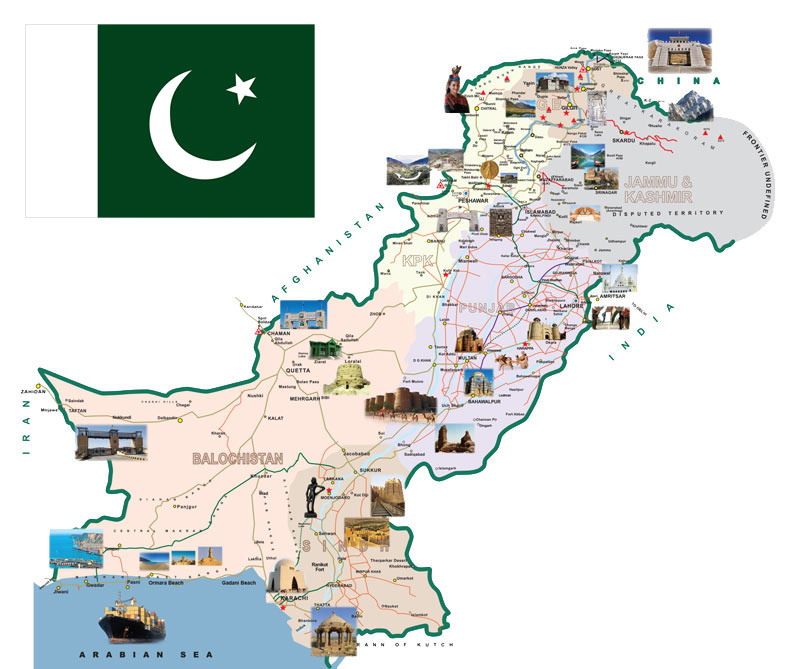Pakistan at a glance
- Home
- Pakistan at a glance
Pakistan
Area – 881,913 sq. km.
Population – 230 million
Capital – Islamabad
Time zone – +5 GMT
Currency – Pakistan Rupee (PKR)
Electricity – 230V – 50Hz
Languages – National language is Urdu. Punjabi, Sindhi, Pashto, and Baluchi are regional languages. English is understood in general.

Ethnicity:
Pakistan has diverse ethnic communities. The ethnic divisions in Pakistan are Punjabis, Sindhis, Pashtoons, Baluchis, Baltis, Gilgitis etc. These are based in the 4 major provinces as well as the region of Gilgit-Baltistan. Besides these many smaller ethnicities live in Pakistan too.
The northern area of Pakistan has many spoken dialects too. Languages like Balti, Shina, Brushiski, Chitrali, Kalasha, as well as Brahui. The Brahuis is a subgroup of the Dravidian people. Their culture has faded but their language still lives on.
Modern-day Pakistan is an amalgamation of the Indo-Aryan races. The Persian, Turkish, and Arab roots make up modern Pakistani.
Hindus in Sindh have managed to keep their culture and religion intact. They have survived the test of time. The Kailash tribe living in the north of Pakistan is one of the best-known minority groups of the world.
Fruits:
Kinoo citrus – From Jan-Feb
Central Pakistan is home to citrus orchards full of kinoo, a mandarin-looking fruit resembling oranges and grapefruit.
Mango mania – From Jun-Aug
The mango gardens of central Pakistan produce close to 200 varieties of mangoes. A mania occurs. Cut pieces, ice cream, or bakery delights are produced with this king of fruits.
Date fruit harvesting – From Jul-Sep
A wonderful sight to behold. See the harvesting and processing of the local varieties of dates. In Sukkur, there is a date bazaar too.
This is not all. Pakistan is home to apricots, apples, grapes, peaches, plums, and much more. Hunza, the fabled land is known for its ‘Apricot Blossom.’ This happens in March and April. At this time the whole valley is full of Apricot trees. This is also the beginning of the plowing season.
In olden times, the Mir of Hunza used to spray the fields with gold dust. This is an old custom performed initially by the Persian kings to announce the coming of the Nowroz festival on the first equinox.
Cuisine and Culinary delights!
Pakistan is a food lovers delight. The food is mildly spiced and has a great taste. Pakistan food has shades of Caucasian food. The spices used make it a wonderful experience to behold. Because of their connections with western and central Asia, Pakistani are great lovers of meat, be it any kind. The charcoal skewered kebabs of mutton, beef, and chicken have delectable tastes. To add to this the savoury curries are perhaps the best in the world. A Pakistani dining table is a mouthwatering dastarkhwan, full of a variety of cuisine. Visit the food streets in many cities. They are laced with traditional restaurants.
Enjoy Pakistani food to your heart’s content.
The southern part of Pakistan has more spicy and hot food, the central and northern parts have mild and less spicy food. Skewered kebabs and curries grace every nook and corner in Pakistani markets. The delectable chapli-kebab is also a great taste to go for.
Pulao or pilaf rice is cooked in large cauldrons in different varieties. It is always on the table with its assortment of vegetables and lentils to go with it.
Naan is the over-fresh bread of Pakistan. It comes smoking hot and is available in earthen overs called tandoors at almost every nook and corner.
The coastline of Pakistan has amazing seafood. A wide choice of fish, crabs, prawns, calamari are available to enjoy. In the north, there is a demand for fresh water river fish. Raho in Punjab and trouts in the icy north are the fish of choice.
No Pakistani meal is complete without a dessert. The whole of Pakistan has a huge variety of local sweet dishes. Pakistani people love their tea or chai as it is known here. Team with green cardamom with a dash of lemon and ginger is irresistible. It helps down the greasy food and to digest it too.
What to wear:
Pakistan is a Muslim country. Modest dresses are worn everywhere. The national dress of Pakistan is the ‘Shalwar Kameez’, which has its origins in the nomadic tribes from the northeast settled in the lands at different points of time in history.
A large number of urban people follow European dressing. This is usually associated with office working people. The national dress is widely worn. It usually is made of cotton and assorted colors. The colorful female fashions are greatly admired and appreciated by foreigners visiting Pakistan.
Head scarves are common with girls while the boys wear either a simple shalwar kameez or maybe western casuals.
Most orthodox ladies like to cover their faces but a large number wear a scarf without covering their faces. Modest dressing is usually preferred by all the people in Pakistan. At sacred places, visitors are expected to cover their heads and remove footwear when entering.
In summer people dress in cotton with a hat or a cap and a pair of sunglasses. Cotton trousers and T-shirts and slacks will keep you comfortable.
In winter make sure to have a warm cardigan or a jacket in the south and central part of Pakistan. In the north, where the cold is harsh, a good jacket, with warm dressing and a cap that keeps you warm is preferred.
Men wear traditional headdresses which are known as either a Chitrali or a Hunzai cap.
Ladies like to wear embroidered caps with intricate designs. These are colorful and admired by tourists.
In Sindh and Baluchistan, med adorn the traditional Sindhi or Baluchi topi.
Pakistan has a variety of costumes and dresses. These are embellished and colorful for the ladies, while the men like to wear white, creamy, or dark solid shades.

